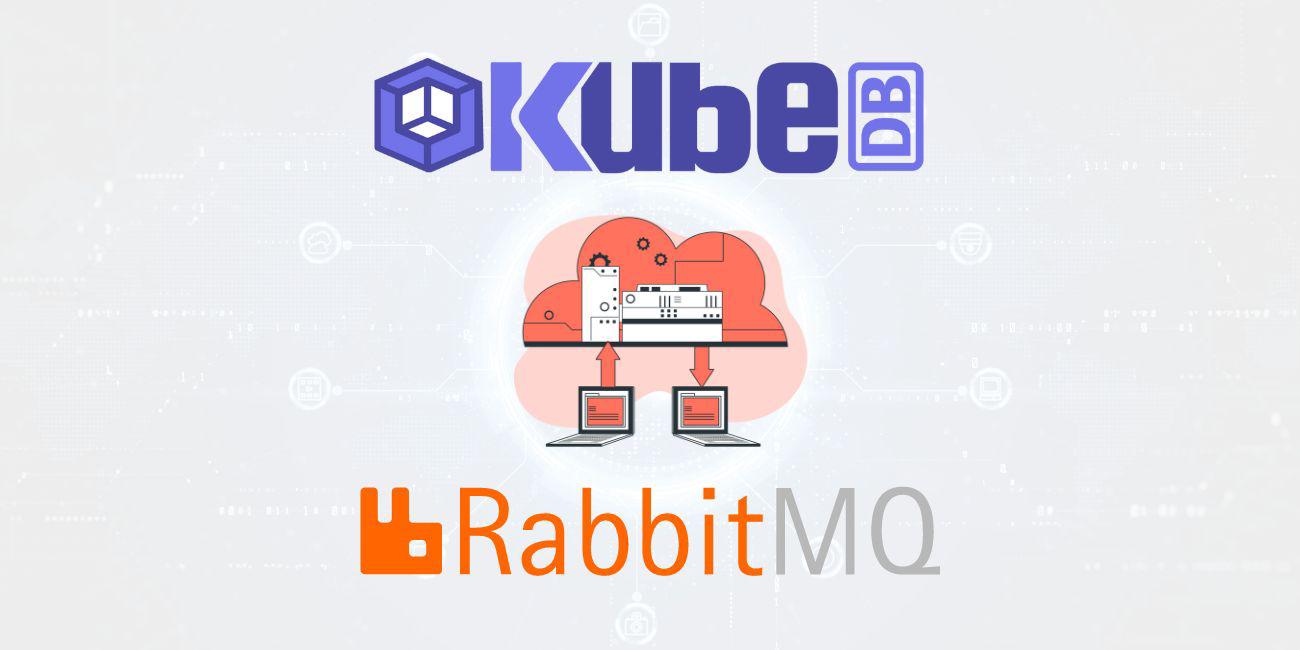
Overview
RabbitMQ is a very well known and highly used messaging and streaming broker, which is easy to deploy on cloud environments, on-premises, and on your local machine. It is currently used by millions worldwide. However, from provisioning RabbitMQ on kubernetes with stable cluster configuration and managing production operations like scaling, monitoring, ensuring security etc. are often proved as a hurdle for many systems. KubeDB is the Kubernetes Native Database Management Solution which simplifies and automates routine database tasks such as Provisioning, Monitoring, Upgrading, Patching, Scaling, Volume Expansion, Backup, Recovery, Failure detection, and Repair for various popular databases on private and public clouds. The wide range of databases supported by KubeDB include MongoDB, Elasticsearch, MySQL, MariaDB, Redis, PostgreSQL, FerretDB, Percona XtraDB and Memcached. Additionally, KubeDB also supports ProxySQL, PgBouncer and the streaming platform Kafka, RabbitMQ. Basically, it’s a one operator solution for all of these databases. In order migrate to KubeDB managed RabbitMQ cluster Blue-green deployment strategy can be adopted. It is an upgrade strategy that is based on the idea of setting up a second RabbitMQ cluster (the “green” one) next to the current production cluster (the “blue” one). Producer and Consumer Application traffics are then switched to the “green” cluster. When that migration is done, the “blue” cluster can be decommissioned (shut down). To simplify the switch, federated queues can be used to transfer enqueued messages from the “blue” to the “green” cluster.
In this tutorial we will Migrate a RabbitMQ cluster hosted on CloudAMQP to a newly deployed KubeDB managed RabbitMQ cluster Using Blue-Green Deployment Strategy.
RabbitMQ Blue Cluster
We have an existing cluster in CloudAMQP, which has a queue named music-queue that is continuously being published to and consumed by microservices.
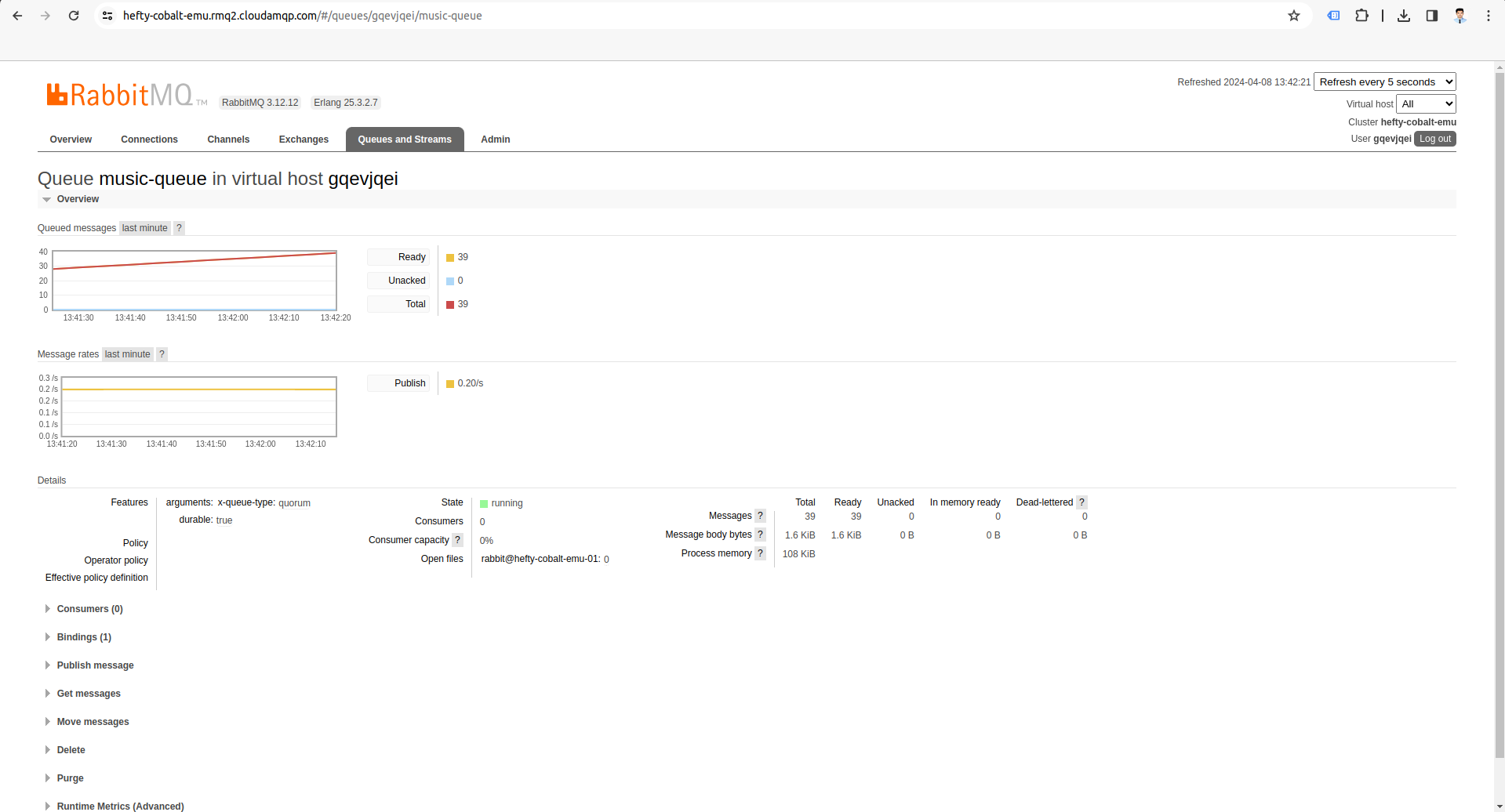
In this tutorial, we will consider CloudAMQP as our Blue cluster and GKE as our Green cluster. So, we will migrate this music-queue from CloudAMQP to Google Kubernetes Engine (GKE) via Blue-Green deployment strategy.
Preparing the “green” Cluster
We have created a new cluster in Google Kubernetes Engine (GKE). After creating a new cluster where we will migrate our existing RabbitMQ cluster, there are two steps to follow:
- import definitions, e.g. exchanges, queues, bindings
- configure federation to later drain messages
Importing definitions
The procedure of definitions export/import is covered in the Backup guide . The “blue” is the source cluster and the “green” one is the target.
Install KubeDB
Get Cluster ID
We need the cluster ID to get the KubeDB License. To get cluster ID, we can run the following command:
$ kubectl get ns kube-system -o jsonpath='{.metadata.uid}'
8e336615-0dbb-4ae8-b72f-2e7ec34c399d
Get License
Go to Appscode License Server to get the license.txt file. For this tutorial we will use KubeDB.
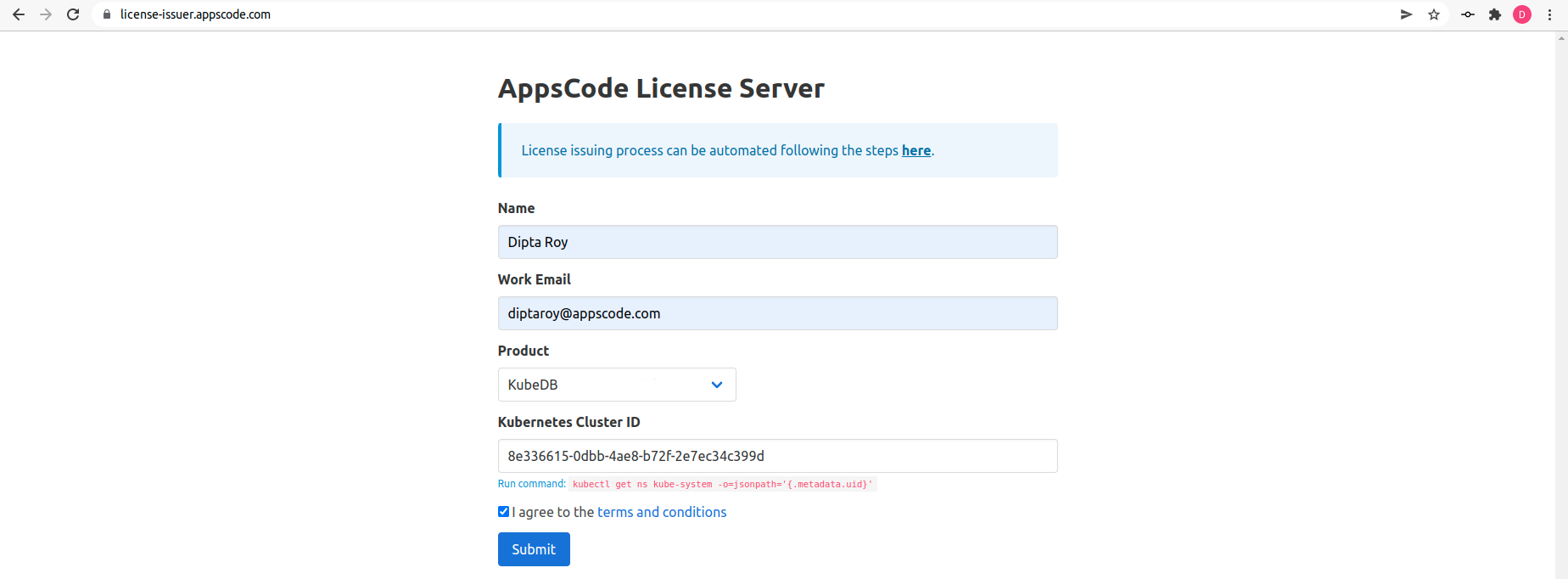
We will use helm to install KubeDB. Please install helm here
if it is not already installed.
Now, let’s install KubeDB.
$ helm search repo appscode/kubedb
NAME CHART VERSION APP VERSION DESCRIPTION
appscode/kubedb v2024.3.16 v2024.3.16 KubeDB by AppsCode - Production ready databases...
appscode/kubedb-autoscaler v0.29.0 v0.29.0 KubeDB Autoscaler by AppsCode - Autoscale KubeD...
appscode/kubedb-catalog v2024.3.16 v2024.3.16 KubeDB Catalog by AppsCode - Catalog for databa...
appscode/kubedb-community v0.24.2 v0.24.2 KubeDB Community by AppsCode - Community featur...
appscode/kubedb-crd-manager v0.0.8 v0.0.8 KubeDB CRD Manager by AppsCode
appscode/kubedb-crds v2024.3.16 v2024.3.16 KubeDB Custom Resource Definitions
appscode/kubedb-dashboard v0.20.0 v0.20.0 KubeDB Dashboard by AppsCode
appscode/kubedb-enterprise v0.11.2 v0.11.2 KubeDB Enterprise by AppsCode - Enterprise feat...
appscode/kubedb-grafana-dashboards v2024.3.16 v2024.3.16 A Helm chart for kubedb-grafana-dashboards by A...
appscode/kubedb-kubestash-catalog v2024.3.16 v2024.3.16 KubeStash Catalog by AppsCode - Catalog of Kube...
appscode/kubedb-metrics v2024.3.16 v2024.3.16 KubeDB State Metrics
appscode/kubedb-one v2023.12.28 v2023.12.28 KubeDB and Stash by AppsCode - Production ready...
appscode/kubedb-ops-manager v0.31.0 v0.31.0 KubeDB Ops Manager by AppsCode - Enterprise fea...
appscode/kubedb-opscenter v2024.3.16 v2024.3.16 KubeDB Opscenter by AppsCode
appscode/kubedb-provider-aws v2024.3.16 v0.6.0 A Helm chart for KubeDB AWS Provider for Crossp...
appscode/kubedb-provider-azure v2024.3.16 v0.6.0 A Helm chart for KubeDB Azure Provider for Cros...
appscode/kubedb-provider-gcp v2024.3.16 v0.6.0 A Helm chart for KubeDB GCP Provider for Crossp...
appscode/kubedb-provisioner v0.44.0 v0.44.0 KubeDB Provisioner by AppsCode - Community feat...
appscode/kubedb-schema-manager v0.20.0 v0.20.0 KubeDB Schema Manager by AppsCode
appscode/kubedb-ui v2024.2.13 0.6.4 A Helm chart for Kubernetes
appscode/kubedb-ui-server v2021.12.21 v2021.12.21 A Helm chart for kubedb-ui-server by AppsCode
appscode/kubedb-webhook-server v0.20.0 v0.20.0 KubeDB Webhook Server by AppsCode
$ helm install kubedb oci://ghcr.io/appscode-charts/kubedb \
--version v2024.3.16 \
--namespace kubedb --create-namespace \
--set global.featureGates.RabbitMQ=true \
--set-file global.license=/path/to/the/license.txt \
--wait --burst-limit=10000 --debug
Let’s verify the installation:
$ kubectl get pods --all-namespaces -l "app.kubernetes.io/instance=kubedb"
NAMESPACE NAME READY STATUS RESTARTS AGE
kubedb kubedb-kubedb-autoscaler-685c67d884-kw6gr 1/1 Running 0 81s
kubedb kubedb-kubedb-ops-manager-65f59c5d4d-24mph 1/1 Running 0 81s
kubedb kubedb-kubedb-provisioner-76867965c4-49b5c 1/1 Running 0 81s
kubedb kubedb-kubedb-webhook-server-7fd7894ff6-wrrhr 1/1 Running 0 81s
kubedb kubedb-petset-operator-5d94b4ddb8-p8nnc 1/1 Running 0 81s
kubedb kubedb-petset-webhook-server-6b9dc556d5-whxq2 2/2 Running 0 81s
kubedb kubedb-sidekick-5dc87959b7-twjtm 1/1 Running 0 81s
We can list the CRD Groups that have been registered by the operator by running the following command:
$ kubectl get crd -l app.kubernetes.io/name=kubedb
NAME CREATED AT
connectclusters.kafka.kubedb.com 2024-04-09T05:52:24Z
connectors.kafka.kubedb.com 2024-04-09T05:52:25Z
druidversions.catalog.kubedb.com 2024-04-09T05:49:53Z
elasticsearchautoscalers.autoscaling.kubedb.com 2024-04-09T05:52:20Z
elasticsearchdashboards.elasticsearch.kubedb.com 2024-04-09T05:52:20Z
elasticsearches.kubedb.com 2024-04-09T05:52:19Z
elasticsearchopsrequests.ops.kubedb.com 2024-04-09T05:52:19Z
elasticsearchversions.catalog.kubedb.com 2024-04-09T05:49:53Z
etcdversions.catalog.kubedb.com 2024-04-09T05:49:54Z
ferretdbversions.catalog.kubedb.com 2024-04-09T05:49:54Z
kafkaautoscalers.autoscaling.kubedb.com 2024-04-09T05:52:26Z
kafkaconnectorversions.catalog.kubedb.com 2024-04-09T05:49:54Z
kafkaopsrequests.ops.kubedb.com 2024-04-09T05:52:25Z
kafkas.kubedb.com 2024-04-09T05:52:24Z
kafkaversions.catalog.kubedb.com 2024-04-09T05:49:55Z
mariadbarchivers.archiver.kubedb.com 2024-04-09T05:52:31Z
mariadbautoscalers.autoscaling.kubedb.com 2024-04-09T05:52:30Z
mariadbdatabases.schema.kubedb.com 2024-04-09T05:52:30Z
mariadbopsrequests.ops.kubedb.com 2024-04-09T05:52:30Z
mariadbs.kubedb.com 2024-04-09T05:52:29Z
mariadbversions.catalog.kubedb.com 2024-04-09T05:49:55Z
memcachedversions.catalog.kubedb.com 2024-04-09T05:49:55Z
mongodbarchivers.archiver.kubedb.com 2024-04-09T05:52:39Z
mongodbautoscalers.autoscaling.kubedb.com 2024-04-09T05:52:39Z
mongodbdatabases.schema.kubedb.com 2024-04-09T05:52:41Z
mongodbopsrequests.ops.kubedb.com 2024-04-09T05:52:38Z
mongodbs.kubedb.com 2024-04-09T05:52:37Z
mongodbversions.catalog.kubedb.com 2024-04-09T05:49:56Z
mysqlarchivers.archiver.kubedb.com 2024-04-09T05:52:49Z
mysqlautoscalers.autoscaling.kubedb.com 2024-04-09T05:52:48Z
mysqldatabases.schema.kubedb.com 2024-04-09T05:52:52Z
mysqlopsrequests.ops.kubedb.com 2024-04-09T05:52:47Z
mysqls.kubedb.com 2024-04-09T05:52:46Z
mysqlversions.catalog.kubedb.com 2024-04-09T05:49:56Z
perconaxtradbversions.catalog.kubedb.com 2024-04-09T05:49:56Z
pgbouncerversions.catalog.kubedb.com 2024-04-09T05:49:57Z
pgpoolversions.catalog.kubedb.com 2024-04-09T05:49:57Z
postgresarchivers.archiver.kubedb.com 2024-04-09T05:53:00Z
postgresautoscalers.autoscaling.kubedb.com 2024-04-09T05:52:59Z
postgresdatabases.schema.kubedb.com 2024-04-09T05:53:01Z
postgreses.kubedb.com 2024-04-09T05:52:57Z
postgresopsrequests.ops.kubedb.com 2024-04-09T05:52:58Z
postgresversions.catalog.kubedb.com 2024-04-09T05:49:57Z
proxysqlversions.catalog.kubedb.com 2024-04-09T05:49:58Z
publishers.postgres.kubedb.com 2024-04-09T05:53:01Z
rabbitmqs.kubedb.com 2024-04-09T05:53:06Z
rabbitmqversions.catalog.kubedb.com 2024-04-09T05:49:58Z
redisautoscalers.autoscaling.kubedb.com 2024-04-09T05:53:11Z
redises.kubedb.com 2024-04-09T05:53:10Z
redisopsrequests.ops.kubedb.com 2024-04-09T05:53:11Z
redissentinelautoscalers.autoscaling.kubedb.com 2024-04-09T05:53:13Z
redissentinelopsrequests.ops.kubedb.com 2024-04-09T05:53:13Z
redissentinels.kubedb.com 2024-04-09T05:53:12Z
redisversions.catalog.kubedb.com 2024-04-09T05:49:58Z
singlestoreversions.catalog.kubedb.com 2024-04-09T05:49:59Z
solrversions.catalog.kubedb.com 2024-04-09T05:49:59Z
subscribers.postgres.kubedb.com 2024-04-09T05:53:01Z
zookeeperversions.catalog.kubedb.com 2024-04-09T05:49:59Z
We recommend you to install the latest KubeDB version available
Deploy KubeDB RabbitMQ to the Green Cluster
We are going to Deploy RabbitMQ by using KubeDB. First, let’s create a Namespace in which we will deploy RabbitMQ.
$ kubectl create namespace rabbit
namespace/rabbit created
Here is the yaml of the RabbitMQ CR we are going to use:
apiVersion: kubedb.com/v1alpha2
kind: RabbitMQ
metadata:
name: rabbitmq-green
namespace: rabbit
spec:
version: "3.12.12"
replicas: 3
storage:
accessModes:
- ReadWriteOnce
resources:
requests:
storage: 1Gi
storageClassName: standard
storageType: Durable
terminationPolicy: WipeOut
podTemplate:
spec:
containers:
- name: rabbitmq
resources:
requests:
cpu: "0.5"
memory: "1Gi"
limits:
memory: "2Gi"
serviceTemplates:
- alias: primary
spec:
type: LoadBalancer
Let’s save this yaml configuration into rabbitmq-green.yaml
Then create the above RabbitMQ CR,
$ kubectl apply -f rabbitmq-green.yaml
rabbitmq.kubedb.com/rabbitmq-green created
In this yaml,
spec.versionfield specifies the version of RabbitMQ. Here, we are using RabbitMQ3.12.12. You can list the KubeDB supported versions of RabbitMQ by running$ kubectl get rabbitmqversionscommand.spec.storage.storageClassNameis the name of the StorageClass used to provision PVCs.spec.serviceTemplatesfield will allow you to set the type and other properties of the services.
Once these are handled correctly and the RabbitMQ object is deployed, you will see that the following objects are created:
$ kubectl get all -n rabbit
NAME READY STATUS RESTARTS AGE
pod/rabbitmq-green-0 1/1 Running 0 106s
pod/rabbitmq-green-1 1/1 Running 0 65s
pod/rabbitmq-green-2 1/1 Running 0 41s
NAME TYPE CLUSTER-IP EXTERNAL-IP PORT(S) AGE
service/rabbitmq-green LoadBalancer 10.5.188.11 34.123.239.45 15672:31855/TCP,5672:31777/TCP 107s
service/rabbitmq-green-pods ClusterIP None <none> 4369/TCP,25672/TCP 107s
NAME TYPE VERSION AGE
appbinding.appcatalog.appscode.com/rabbitmq-green kubedb.com/rabbitmq 3.12.12 109s
Let’s check if the rabbitmq-green is ready to use,
$ kubectl get rabbitmq -n rabbit rabbitmq-green
NAME TYPE VERSION STATUS AGE
rabbitmq-green kubedb.com/v1alpha2 3.12.12 Ready 3m7s
We have successfully deployed RabbitMQ cluster in GKE.
RabbitMQ Plugins
For this migration, we need to integrate the RabbitMQ Federation Plugin and RabbitMQ Shovel Plugin into our Green cluster (GKE).
Accessing RabbitMQ Green Cluster Through UI
To access RabbitMQ through UI, we have to get the credentials to access. KubeDB will create Secret and Service for the database rabbitmq-green that we have deployed. Let’s check them using the following commands,
$ kubectl get secret -n rabbit
NAME TYPE DATA AGE
rabbitmq-green-admin-cred kubernetes.io/basic-auth 2 16m
rabbitmq-green-config Opaque 2 16m
rabbitmq-green-erlang-cookie Opaque 1 26m
$ kubectl get svc -n rabbit
NAME TYPE CLUSTER-IP EXTERNAL-IP PORT(S) AGE
rabbitmq-green LoadBalancer 10.128.28.64 143.42.79.107 15672:30409/TCP,5672:30528/TCP 16m
rabbitmq-green-pods ClusterIP None <none> 4369/TCP,25672/TCP 16m
rabbitmq-publisher ClusterIP None <none> 80/TCP 4m34s
Now, we are going to use rabbitmq-green-admin-cred to get the credentials.
$ kubectl get secrets -n rabbit rabbitmq-green-admin-cred -o jsonpath='{.data.username}' | base64 -d
admin
$ kubectl get secrets -n rabbit rabbitmq-green-admin-cred -o jsonpath='{.data.password}' | base64 -d
lsOKJ~e0vbv4rErU
We will use the EXTERNAL-IP 143.42.79.107 of rabbitmq-green and the port 15672 to access the UI.


Firstly, we need to establish a new queue named music-queue within our RabbitMQ Green cluster.
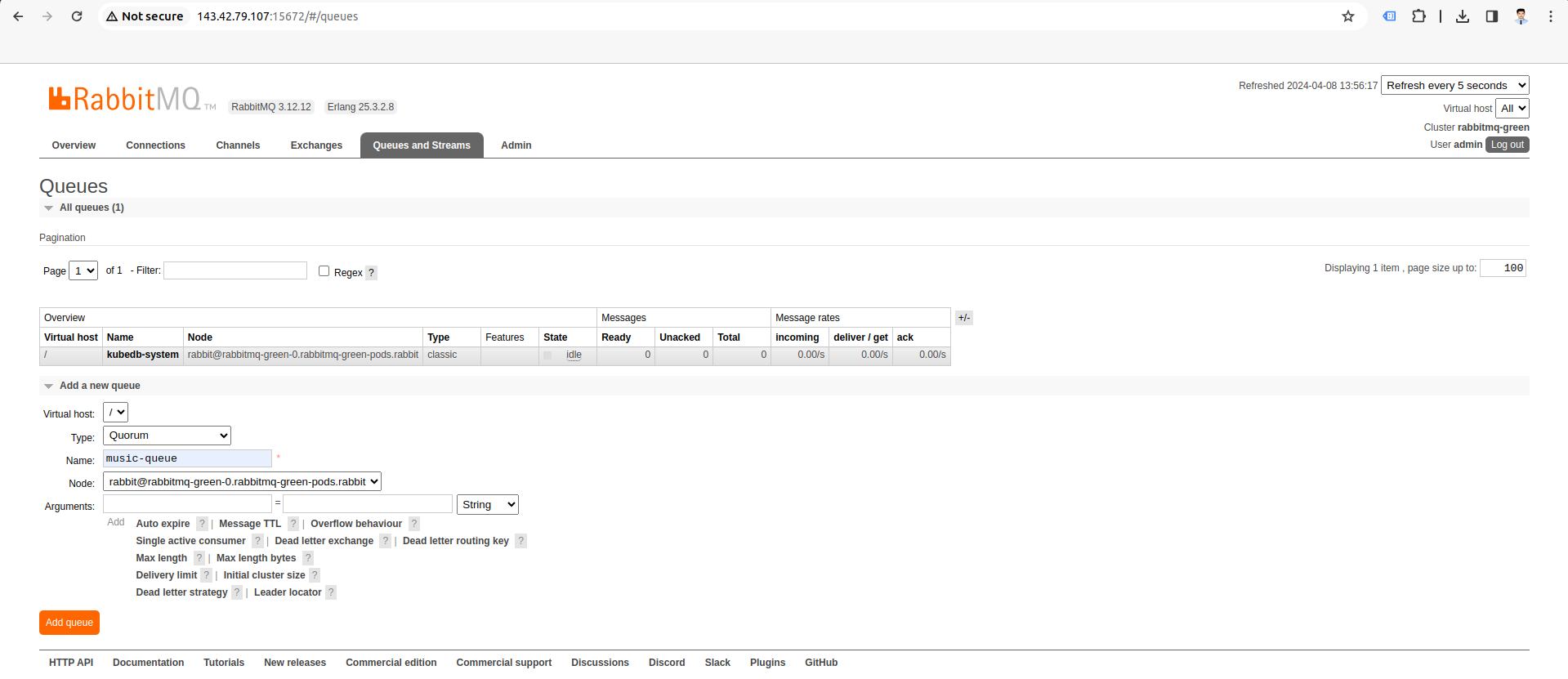
Next, we’ll set up a policy for our music-queue to define specific configurations. Policies in RabbitMQ enable us to automate various aspects of queue management.

Now, we’ll configure a federation upstream to establish a connection with the Blue cluster hosted on CloudAMQP. This connection will enable seamless communication between the two clusters, allowing for message replication and synchronization.
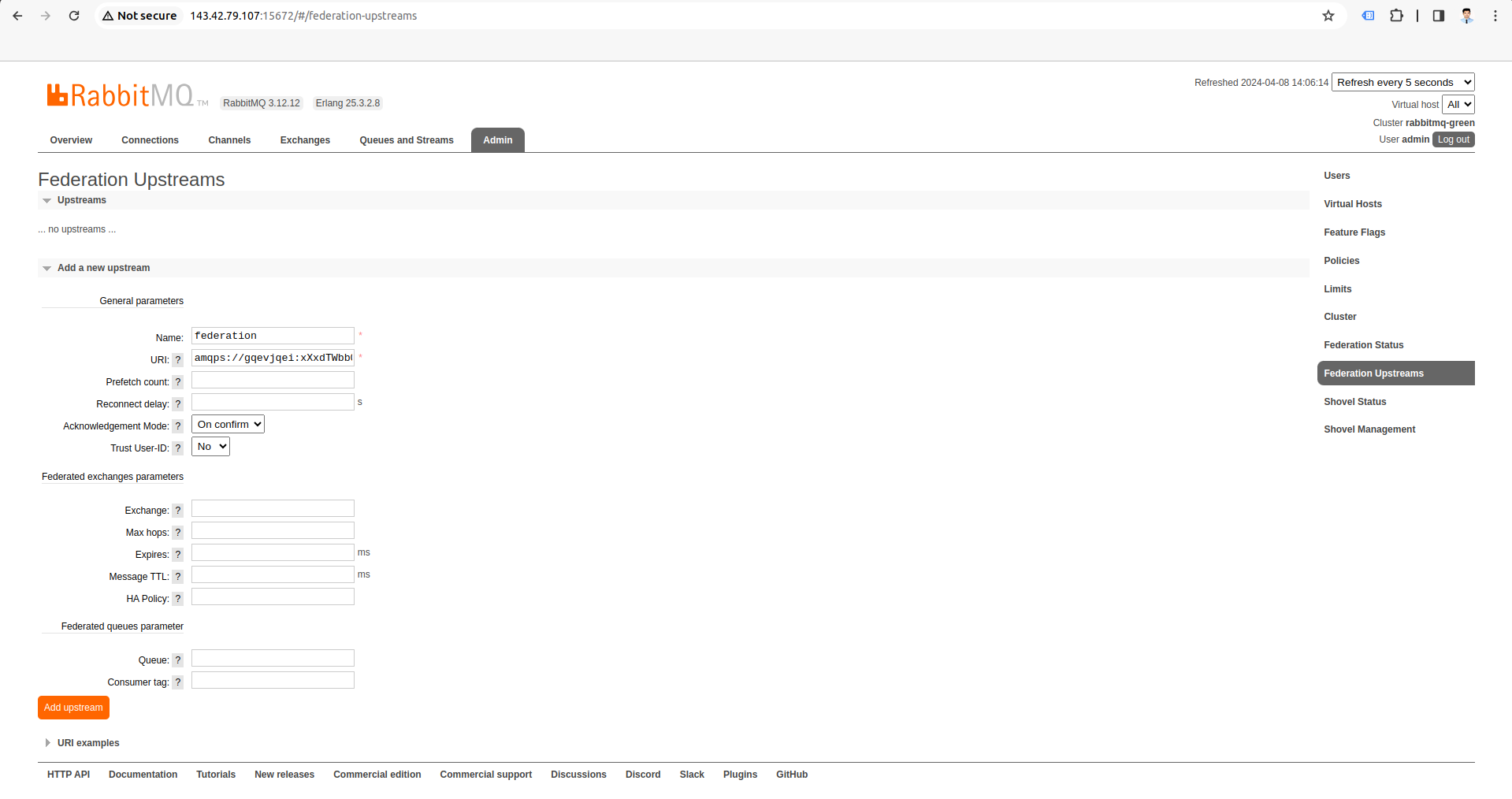
To streamline the migration process and ensure efficient message transfer between clusters, we’ll leverage the RabbitMQ Shovel Plugin. This plugin enables the direct movement of messages from the Blue cluster to the Green cluster, minimizing downtime and data loss.

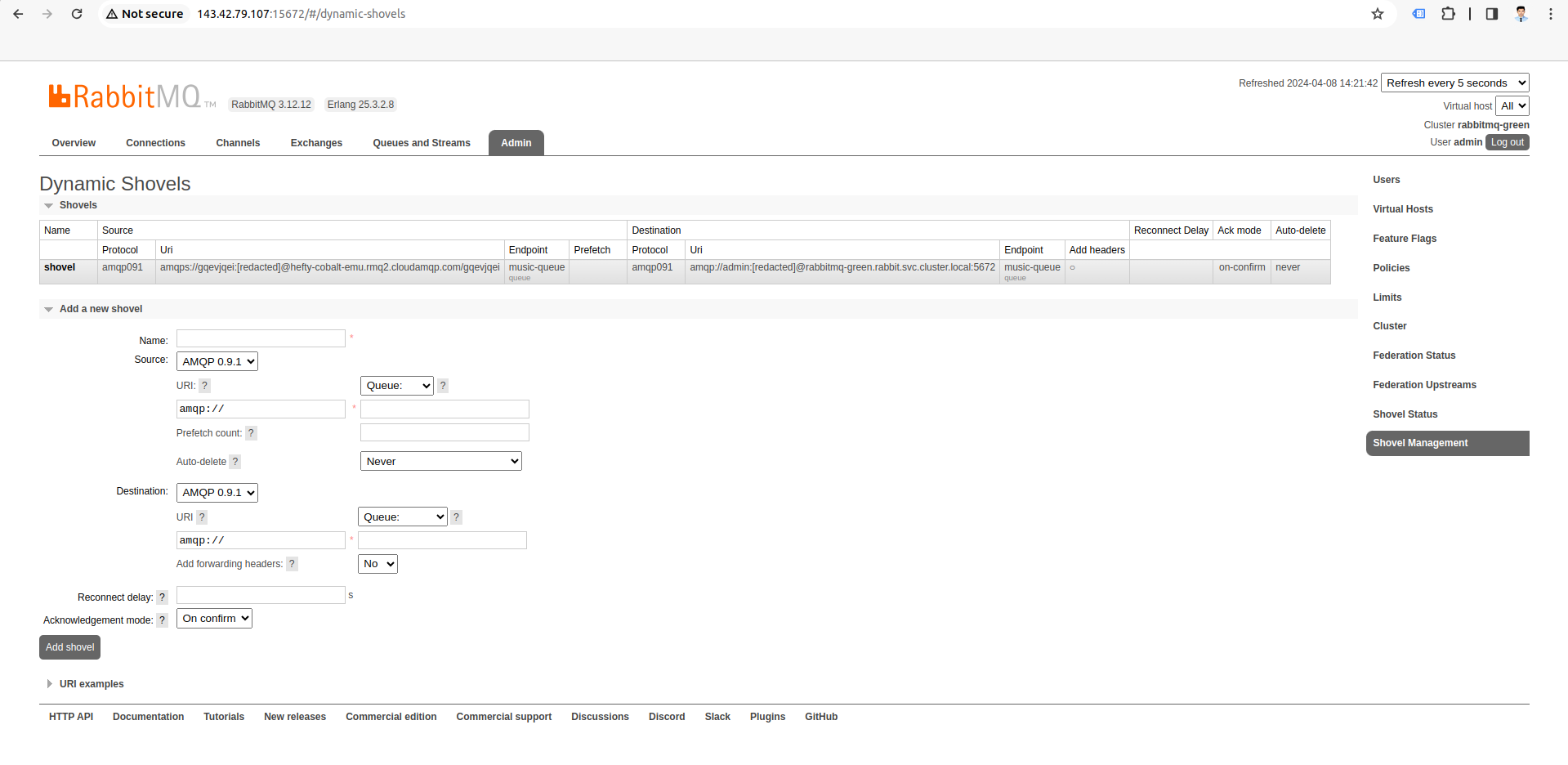
Once all configurations are in place, we can initiate the migration process. Messages will be automatically transferred from the music-queue in the Blue cluster to the corresponding queue in the Green cluster using the configured federation upstream and shovel plugin.
By integrating RabbitMQ Federation Plugin and RabbitMQ Shovel Plugin into our Green cluster, we’ve successfully established a robust infrastructure for migrating our music-queue from the Blue cluster. This approach ensures minimal downtime and data loss, making the transition seamless and efficient.
We have created a detailed video on migrating RabbitMQ to KubeDB using Federation and Shovel. You can have a look at that video below:"
Support
To speak with us, please leave a message on our website .
To receive product announcements, follow us on X .
To watch tutorials of various Production-Grade Kubernetes Tools Subscribe to our YouTube channel.
If you have found a bug with KubeDB or want to request for new features, please file an issue .









